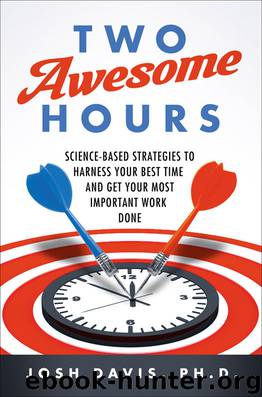Two Awesome Hours: Science-Based Strategies to Harness Your Best Time and Get Your Most Important Work Done by Josh Davis

Author:Josh Davis
Language: eng
Format: mobi
Publisher: HarperCollins
Published: 2015-05-04T14:00:00+00:00
STRATEGY 4
LEVERAGE YOUR MIND–BODY CONNECTION
So far, we’ve discussed how to enjoy a couple of hours of real productivity by taking advantage of your decision points, choosing what tasks to take on and in what order so you can bring the right mental energy to them, and managing your attention effectively once you start a task. These three strategies alone could help you make every day hugely productive—if only you had complete control over your calendar.
But, of course, none of us do. We don’t always have the flexibility to decide to work on a key project when we have the right mental energy for it. Sometimes we find ourselves not thinking very clearly, being anxious, or generally feeling overwhelmed, but our jobs demand that we perform. Often our daily schedules are filled with presentations that were planned weeks ago, deadlines imposed by our bosses or clients, recurring meetings with our colleagues, and so on. In short, sometimes we want to be at our mental best at specified times and for previously scheduled tasks.
For peak mental functioning in these circumstances, we can add one more strategy: leveraging the immediate effects of physical activity and food to improve our mental functioning.
For example, Jennifer—who through the years worked her way up to being the head of human resources for a ten-thousand-plus-person organization—has to meet the Japanese owners of the parent company, who are in town. Twenty minutes before the meeting, her stomach is so knotted up from drinking too much coffee and eating the candies she keeps at her desk, and her neck muscles are so sore from stressing out over reviewing the agenda on her computer again and again, that she is highly distracted and irritable.
Ten minutes before the meeting, she finds herself standing in the bathroom, wishing this hour could just be over. Staring in the mirror, she notices the bags under her eyes that weren’t there that morning. Do I really look that old? she thinks. Her body is broadcasting on the outside what she feels like on the inside. However, as you’ll learn in this strategy, had she gone for a brisk thirty- to forty-minute walk instead of obsessing over her meeting materials, her body could have had a lightness of spirit and mental clarity to broadcast instead.
That our physical states influence our mental states is at once obvious and revolutionary. On one hand, it is obvious because almost everyone has experienced, at some point, how our minds feel sharper when we feel physically great or pretty foggy when we are sick (or when we’re suffering from a food coma). These are the effects of what’s happening in our bodies on our capacity to think.
On the other hand, it is revolutionary because we seldom act on this intuitive knowledge. That’s likely because the idea of the body and the mind influencing each other flies in the face of age-old assumptions in Western thought. For a long time, the mind was treated as though it were independent of the body—and the body was treated perhaps as only a life support system for the mind.
Download
This site does not store any files on its server. We only index and link to content provided by other sites. Please contact the content providers to delete copyright contents if any and email us, we'll remove relevant links or contents immediately.
Nudge - Improving Decisions about Health, Wealth, and Happiness by Thaler Sunstein(7550)
Deep Work by Cal Newport(6856)
Principles: Life and Work by Ray Dalio(6176)
Factfulness: Ten Reasons We're Wrong About the World – and Why Things Are Better Than You Think by Hans Rosling(4675)
The Doodle Revolution by Sunni Brown(4667)
Eat That Frog! by Brian Tracy(4411)
Thinking in Bets by Annie Duke(4140)
Hyperfocus by Chris Bailey(4031)
Visual Intelligence by Amy E. Herman(3710)
Writing Your Dissertation in Fifteen Minutes a Day by Joan Bolker(3660)
Ogilvy on Advertising by David Ogilvy(3483)
How to Win Friends and Influence People in the Digital Age by Dale Carnegie & Associates(3483)
Hidden Persuasion: 33 psychological influence techniques in advertising by Marc Andrews & Matthijs van Leeuwen & Rick van Baaren(3454)
How to win friends and influence people by Dale Carnegie(3382)
The Pixar Touch by David A. Price(3344)
Schaum's Quick Guide to Writing Great Short Stories by Margaret Lucke(3304)
Deep Work: Rules for Focused Success in a Distracted World by Cal Newport(3128)
Work Clean by Dan Charnas(3035)
The Slow Fix: Solve Problems, Work Smarter, and Live Better In a World Addicted to Speed by Carl Honore(2939)
